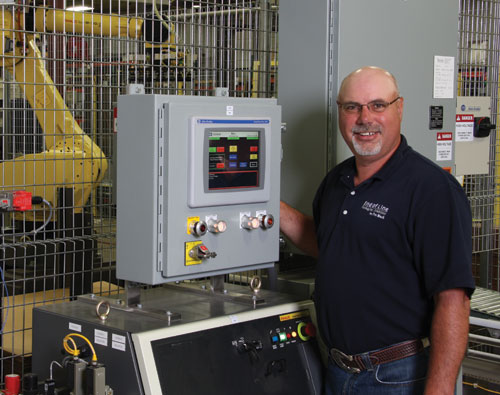
The human machine interface (HMI) next to
Brenton’s Mike Grinager interfaces with an entire packaging line that is
designed to pack and palletize sealed cases of pouches at speeds of 180
products per minute.
Mike Grinager:We are seeing a migration from pneumatics to servo motors. The principal reasons are energy savings and smaller footprint on the machine. With servo motors, the end user also gains precision and some braking. One of the issues for the machine builder is that the more servo motors in use, the bigger the control panel becomes, so Original Equipment Manufacturers (OEMs) must perform a balancing act. Another issue is that servo motors can be more expensive than pneumatics. To reduce the price differential it’s necessary to “right size” the motors.
Human machine interface devices (HMI) go beyond the function of giving the operator a window into the system.HMI’s now include a variety of tools for maintenance personnel. A layer down from what it takes to operate the machine is password protected functionality, which gives maintenance personnel everything they need for preventive maintenance and for break/fix situations, including 3-D renderings of parts, preventive maintenance schedules, interactive help, and video clips of processes. This functionality leads to more consistent and timely preventative maintenance, lower overall time spent with the machine, higher uptime, greater throughput, and a contribution to lowest total cost of ownership.
Remote connectivity between the OEM and the machine will become much more common. One of the hurdles to achieving this is the IT department’s concern about allowing outsiders through the firewall. One solution may be virtual private networks between the OEM and the machine. We anticipate greater usage of on-machine cameras to allow the OEM to actually see critical parts of the machine in operation. However, the quality of the video isn’t quite there yet.
F&BP: What are some of the misconceptions end users have about packaging machines as it relates to automation?
Grinager: End users think that buying a robot and a highly automated machine pretty much eliminates the need for an operator. Automation does lower direct labor, but not as much as people believe. Today’s systems involve complex materials/intelligent machine interactions, and these interactions require some portion of a skilled person’s attention to keep the process operating at peak efficiency.
An analogous situation is the belief that personnel can have remote access to all the inner workings of the machine; for example, down to current on a variable frequency drive. The problem is that today’s machines have a wealth of data available, but not down to that micro level. If an end user wants that capability, it should be planned for before the machine is built. Be aware it can add considerably to the cost.
Sustainability is much discussed today. Ask five people about what sustainability means and you are likely to receive five different answers. There simply are no standards to follow as of yet. Until machine builders and end users start to benchmark where they are in terms of energy, materials usage, and a host of other criteria, then we won’t be able to measure meaningful improvements to economic and environmental sustainability.
F&BP: What’s the most common problem with automation that you hear from customers and what’s the solution?
Grinager: An end user may buy similar machines/control automation from a supplier over a period of time and each machine will likely have a different version of software. What this does is make it a chore to regularly update the various versions of software and pay for those updates. A small number of the suppliers are now making fast and inexpensive online software updates possible. This should help to force the others to follow suit and jettison the cumbersome update process. At least we hope it will.
F&BP: Where do you see automation technology and controls going in the next two years?
Grinager: Software programs will continue to become similar between the various vendors. Command structures and ladder logic will look and feel pretty much the same.
Interestingly, machine builders are acting as system integrators. When there is a core machine in a combination with other packaging machines, the core machine manufacturer will increasingly be given responsibility for tying the combos together for the factory acceptance test.
With these combo integrations, the end user only has one location to visit for the factory acceptance test, not two or three. During the test, operators and maintenance personnel can also receive preliminary training on the combo before it lands on the plant floor. This leads to a faster and more issue-free startup. It’s a bit like system integration on steroids.
For More Information
Brenton Engineering Div. Pro Mach
800-535-2730;www.brentonengineering.com
